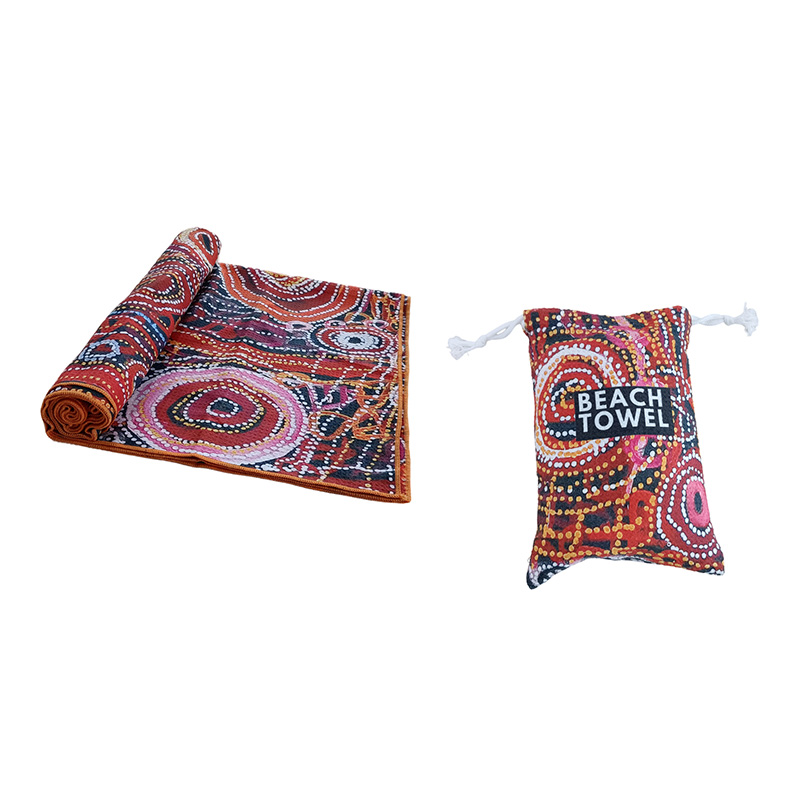If you are interested in some of our products, please feel free to visit our website or contact us for detailed information.
Colorfastness and resistance to fading are critical qualities for any beach towel, including those made from microfiber. Microfiber beach towels are known for their vibrant colors and durability, but it's important to understand how they stack up against other materials like cotton, bamboo, or polyester. Here's a detailed comparison of microfiber's performance in terms of colorfastness and resistance to fading:
Microfiber Beach Towels
Colorfastness Properties
Fiber Structure: Microfiber is composed of extremely fine synthetic fibers, often made from polyester or a blend of polyester and polyamide (nylon). The dense structure of these fibers allows for deep penetration of dyes, leading to excellent color retention.
Dye Affinity: Microfiber has a high affinity for various types of dyes, including disperse dyes, which are commonly used for synthetic fibers. This results in strong color bonds that are less likely to fade.
Heat Setting: Microfiber towels are often heat set during manufacturing, which locks in the dye and enhances colorfastness. This process ensures that the colors remain vibrant even after exposure to water and sunlight.
Resistance to Fading
UV Resistance: The synthetic nature of microfiber provides inherent resistance to UV radiation. This helps prevent the colors from breaking down and fading when exposed to sunlight, a common issue for beach towels.
Chemical Resistance: Microfiber’s synthetic fibers are resistant to many chemicals, including chlorine and saltwater, which are common causes of color fading in natural fibers like cotton.
Abrasion Resistance: Microfiber has a smooth surface and tight weave, reducing friction and abrasion that can cause colors to wear off. This makes microfiber towels less likely to show signs of wear and tear.
Comparison with Other Materials
Cotton Beach Towels
Colorfastness: Cotton has a natural affinity for dyes and typically absorbs color well. However, it can be prone to color bleeding and fading, especially with repeated washing. Cotton dyes may not bond as strongly as those used for microfiber.
Resistance to Fading: Cotton is more susceptible to UV degradation and chemical exposure (like chlorine and saltwater), which can cause significant fading over time. Cotton fibers also tend to wear down more quickly, leading to loss of color vibrancy.

Bamboo Beach Towels
Colorfastness: Bamboo fibers can absorb dyes well, but their natural properties may not hold color as effectively as synthetic fibers. Bamboo towels may require special dyes and treatments to achieve comparable colorfastness to microfiber.
Resistance to Fading: Bamboo is less resistant to UV exposure and chemical degradation compared to microfiber. While bamboo is more environmentally friendly, it might not retain its color as well under harsh conditions like those at the beach.
Polyester Beach Towels
Colorfastness: Polyester, like microfiber, has excellent dye retention properties, especially when dyed with disperse dyes. It shares many of the colorfast qualities of microfiber due to its synthetic nature.
Resistance to Fading: Polyester is resistant to UV and chemical damage, making it a good option for maintaining color over time. However, microfiber often provides a softer feel and better absorbency compared to standard polyester.
Blended Fabrics
Colorfastness: Blends of natural and synthetic fibers (such as cotton-polyester) can offer a balance between the natural comfort of cotton and the durability of synthetics. However, the natural component can still lead to some color fading.
Resistance to Fading: Blended fabrics may offer improved resistance to fading compared to pure cotton, but typically not as much as pure synthetic fibers like microfiber. The proportion of synthetic to natural fibers plays a key role in the overall performance.
Summary of Colorfastness and Fading Resistance
Microfiber Beach Towels: Offer superior colorfastness and resistance to fading due to their synthetic fiber composition, deep dye penetration, and resistance to UV and chemical exposure.
Cotton Beach Towels: Generally have good initial color vibrancy but are prone to fading due to UV exposure and chemical degradation. They require more maintenance to retain color.
Bamboo Beach Towels: Eco-friendly but may not retain colors as effectively as synthetic options. They are more susceptible to fading from environmental factors.
Polyester Beach Towels: Share many of the colorfast and fading-resistant properties of microfiber but might not provide the same level of softness and absorbency.
Blended Fabrics: Offer a compromise between natural and synthetic properties, providing moderate color retention and durability.








